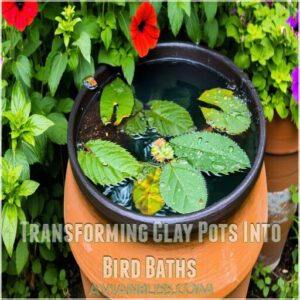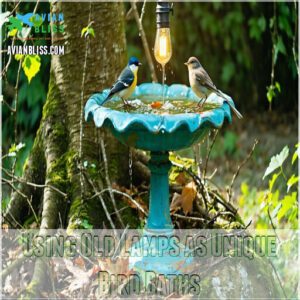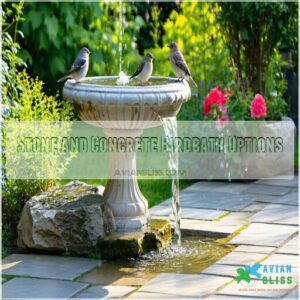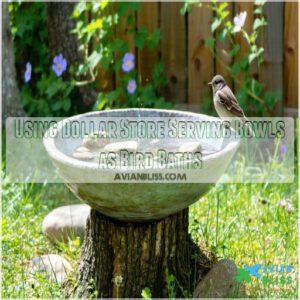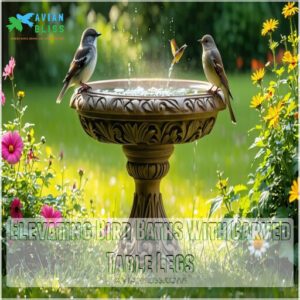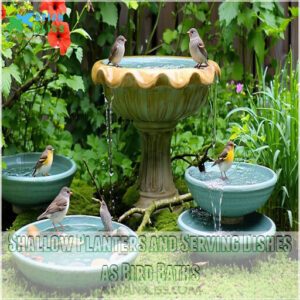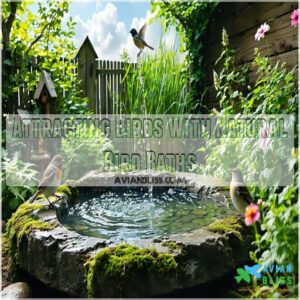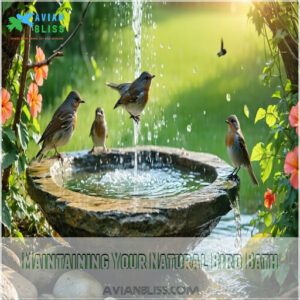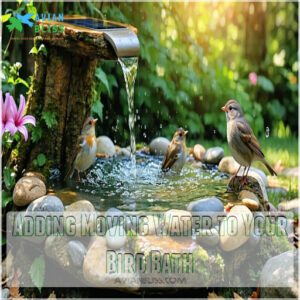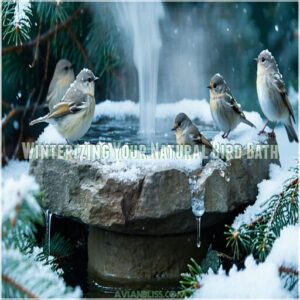This site is supported by our readers. We may earn a commission, at no cost to you, if you purchase through links.
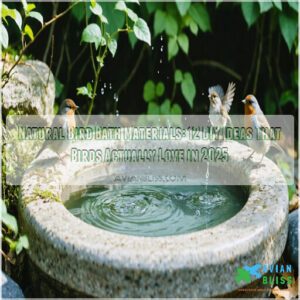
You can use durable granite, DIY-friendly cement and clay, or get creative with repurposed stones and upcycled materials like old lamps and teacups.
These natural bird bath materials will attract birds to your outdoor space, and with a little maintenance, you’ll be enjoying their songs in no time.
Now, let’s explore some unique ideas to make your bird bath a haven for your feathered friends, and discover the perfect natural bird bath materials for your yard.
Table Of Contents
- Key Takeaways
- Choosing Natural Bird Bath Materials
- Upcycled Materials for Bird Baths
- Stone and Concrete Birdbath Options
- Hanging and Serving Dish Bird Baths
- Attracting Birds With Natural Bird Baths
- Maintaining Your Natural Bird Bath
- Adding Moving Water to Your Bird Bath
- Wildlife Concerns With Natural Bird Baths
- Winterizing Your Natural Bird Bath
- Tips for Building a Natural Bird Bath
- Frequently Asked Questions (FAQs)
- What is the best material for a bird bath?
- How to make a natural bird bath?
- What is an alternative to a bird bath?
- Why put marbles in bird bath?
- What is a bird bath made of?
- What are the best birdbaths?
- Can you make a bird bath with upcycled materials?
- How to make a bird bath?
- What can you put in a birdbath?
- What’s the best material for a bird bath?
- Conclusion
Key Takeaways
- You’ll want to choose natural bird bath materials like granite, stone, or concrete, which are durable and weather-resistant, to create a low-maintenance and beautiful bird bath that’ll attract birds to your yard.
- You can get creative with DIY projects using upcycled materials like old lamps, vintage glassware, or repurposed stone to add a personal touch to your outdoor space and make it a haven for birds.
- To keep your bird bath clean and fresh, you’ll need to change the water regularly, use a stiff brush to scrub away grime, and consider adding moving water features like solar-powered fountains or misters to prevent algae and bacteria buildup.
- By providing fresh water, proper care, and considering the right materials, you’ll be well on your way to making your yard a haven for birds, and with minimal maintenance, you’ll enjoy their songs and have a beautiful outdoor space that’s perfect for relaxation.
Choosing Natural Bird Bath Materials
You’ll love creating a backyard oasis with natural materials like granite, cement, and repurposed stone that’s perfect for your feathered friends.
Whether you’re building a DIY bird bath from scratch or sprucing up an existing one, these weather-resistant options won’t break the bank and they’ll keep your birds splashing happily all year long with natural materials.
Granite for All-Weather Bird Baths
Regarding natural bird bath materials, granite stands out as nature’s perfect choice for your feathered friends.
You’ll love how this weather-resistant wonder laughs in the face of freezing temperatures without cracking or splitting.
Your granite bird bath won’t just survive winter – it’ll thrive through every season.
Here’s why granite’s a smart pick:
- Natural aesthetics that blend beautifully with any garden style
- Stone durability that withstands years of pecking and splashing
- Bird safety features like textured surfaces for secure footing
- Zero maintenance headaches – just occasional cleaning keeps it pristine
Though it’s pricier upfront, think of it as a lifetime investment in your garden’s joy.
Granite bird baths are often available with free shipping options that make them more accessible to everyone.
Cement and Clay for Bird Baths
Molding a cement bird bath or a clay bird bath is a fantastic DIY project that’s both budget-friendly and creative.
With clay mixtures and different cement types, you can shape unique bird bath designs, from rustic bowls to modern sculptures.
These natural bird bath materials are durable but can heat up, so place them in a shady spot.
Try using clay saucers for a quick, charming setup, it’s an easy way to pamper your feathered visitors.
For a more attractive setup, consider using natural bird materials to create a unique bird bath environment, and make it a natural bird bath with a unique environment.
Repurposed Stone for Rustic Bird Baths
Got some old stones lying around? Turn them into a charming repurposed stone bird bath!
Stack flat stones for a zen-like vibe or carve a hollow in a large rock for a natural stone birdbath centerpiece.
Mix textures for rustic designs that blend effortlessly with your garden. Add pebbles for bird safety and shallow water features.
Using repurposed materials like this is eco-friendly, budget-smart, and a win for your feathered visitors!
Upcycled Materials for Bird Baths
You’ve probably got some hidden treasures lying around that can make perfect bird baths, like old lamps, clay pots, or even teacups.
Upcycling these items isn’t just eco-friendly—it’s a fun way to get creative while giving your backyard birds a cozy spot to splash around, which is also very fun.
Transforming Clay Pots Into Bird Baths
Got a stack of clay pots just sitting around? Turn them into charming homemade bird baths for outdoors! Clay Pot Designs are perfect for adding a touch of Garden Decor while keeping Bird Bath Safety in mind.
You can purchase clay pot bird bath supplies online.
Here’s how:
- Pick a sturdy clay pot with a wide base and rim.
- Seal drainage holes with waterproof Potting Materials to hold water securely.
Add a shallow saucer on top, fill with water, and voilà—a natural bird bath birds will flock to!
Creating Vintage-Style Bird Baths With Recycled Glass
Turn your old glassware into stunning vintage-style bird baths! With a little creativity, you’ll create a bird-friendly masterpiece from eco materials.
Here’s how:
| Glass Type | DIY Tip | Bird-Safe Advice |
|---|---|---|
| Recycled Bowls | Pair with bases | Sand sharp edges |
| Platters | Mount on pedestals | Maintain stability |
| Glass Vases | Stack for height | Use waterproof adhesive |
| Saucers | Combine for depth | Keep water shallow |
| Vintage Dishes | Add colorful accents | Clean regularly |
Glass recycling never looked so good—your feathered friends will love this DIY birdbath idea!
Using Old Lamps as Unique Bird Baths
Ready to turn an old lamp into a charming DIY bird bath? It’s easier than you think and perfect for outdoor spaces! Repurposed lamps make eco-friendly, vintage bird baths that birds (and neighbors) will love.
Here’s how to create one:
- Remove all electrical parts from the lamp.
- Clean it thoroughly, removing dust and grime.
- Paint the base with weatherproof colors for durability.
- Attach a shallow bowl securely on top.
Place it in a shady spot for bird safety!
Stone and Concrete Birdbath Options
You’re looking for a natural, durable option for your bird bath, and stone and concrete are great choices.
They’re easy to clean, and you can add a personal touch to make them unique, like using simple stone stacks or galvanized trash can lids as basins.
Simple Stone Stacks for Rustic Gardens
Create a rustic garden bird bath with simple stone stacks.
Gather flat rocks, stack them for stability, and add natural accents.
This stone bird bath design blends with your garden’s vibe, offering birds perching spots amidst rock formation and stone textures, perfect for natural materials enthusiasts and rustic landscaping.
Galvanized Trash Can Lids as Bird Bath Basins
You’re upcycling a galvanized trash can lid into a bird bath basin, perfect for a rustic birding setup.
Add some smooth stones for perching spots and stability. This DIY bird bath is a great example of repurposed basins, using metal bird baths to create a natural bird bath.
Your homemade bird bath will attract birds, and with galvanized lids, you’ll have a durable, low-maintenance option for your backyard, a fun DIY project.
The use of galvanized bird baths can enhance the overall aesthetic and functionality of your outdoor space, making it a great way to create a rustic birding setup with a durable and low-maintenance bird bath.
Adding a Personal Touch to Concrete Birdbaths
You can add a personal touch to your concrete bird bath with concrete decor, considering bird safety.
Try:
- Natural accents like pebbles
- Color options for a pop
- Texture choices for visual interest, making your DIY bird bath unique.
Hanging and Serving Dish Bird Baths
You can create a beautiful bird bath using hanging and serving dish options, which are easy to set up and maintain.
By using items like dollar store serving bowls or shallow planters, you can make a unique and functional bird bath that birds will love.
Using Dollar Store Serving Bowls as Bird Baths
You’ll love using dollar store serving bowls as bird baths! They’re lightweight, affordable, and come in various colors.
- Perfect shallow depth
- Variety of patterns
- Easy to handle
- Affordable for multiple baths
Secure them well to prevent tipping and get creative with DIY bird bath ideas, serving bowl tips, and dollar store hacks for a fun birding project!
Elevating Bird Baths With Carved Table Legs
You’re elevating your bird bath game with carved table legs, a great Leg Support idea.
This Table Conversion technique adds a touch of elegance, ensuring Bath Stability.
Wood Carving creates a unique Pedestal Design, perfect for a natural bird bath or wooden bird bath ideas using carved bird bath and DIY bird bath materials.
Shallow Planters and Serving Dishes as Bird Baths
You can create a natural bird bath using shallow planters and serving dishes.
Grab a dusty platter, it’s perfect! Birds prefer water depth no deeper than 3 inches.
Consider a shallow bird bath for pollinators to attract beneficial insects.
This DIY bird bath is easy to set up, budget-friendly, and a great way to reuse old dishes, making it a fun, homemade bird bath for your garden, with the right planter bird baths and dish materials, and a perfect example of a DIY project.
Attracting Birds With Natural Bird Baths
You’re about to create a bird-friendly oasis, and it starts with attracting birds to your natural bird bath.
By providing fresh water, proper care, and considering the right materials, you’ll be well on your way to making your yard a haven for these amazing creatures.
Providing Fresh Water and Proper Care
Your snazzy new bird bath is ready for guests! But, like a good hotel, it needs regular upkeep. Clean water is a must-have for our feathered buddies. Think of it as their spa day!
Here’s the lowdown on keeping your natural bird bath sparkling:
- Freshen up the water supply every couple of days.
- Scrub-a-dub-dub with a non toxic bird bath cleaner and brush.
- Keep the water level steady for easy bird access.
- Toss in a few pebbles for perching spots.
- Check your bird bath maintenance schedule and stick to it!
Good water quality and bird hygiene means happy birds! Preventing algae in bird baths is as easy as pie with these cleaning tips. It’s all about maintaining a natural bird bath and ensuring good water quality.
Creating a One-Stop Shop With Food and Shelter
You’re making a bird paradise.
Add feeders, birdhouses, and sheltering shrubs.
| Bird Feeding | Shelter Designs | Eco Friendly |
|---|---|---|
| Seed | Trees | Native plants |
| Suet | Shrubs | Birdhouses |
| Nectar | Vines | Water sources |
| Fruit | Rocks | Garden planning |
The table outlines various components for the paradise, including feeders, shelter designs, and eco-friendly elements.
Considering Material, Color, and Style
As you pick a bird bath, consider material, color, and style.
You’ve got options:
- Granite for durability
- Ceramic for charm
- Natural stone for texture, blending with your garden aesthetics, and meeting bird preferences with the right bird bath materials and design.
Maintaining Your Natural Bird Bath
You’ll want to keep your natural bird bath clean and fresh, so you’ll need to change the water regularly.
By doing so, you’ll prevent algae and bacteria buildup, making it a safe and healthy spot for birds to visit and play.
Keeping The Water Clean and Fresh
You’ll want to clean your natural bird bath regularly.
Use a stiff brush to scrub away grime, then rinse thoroughly.
This helps maintain fresh water, prevents algae control issues, and supports bacteria removal.
Fresh water is key to a healthy bird bath, so change it every few days for happy, healthy birds.
Preventing Algae and Bacteria Buildup
You’ve kept your bird bath water clean, now prevent algae and bacteria buildup.
Try these 4 natural methods:
- Apple cider vinegar
- A copper penny
- Barley straw
- UV light purifier, for a fresh, natural bird bath with great water quality and effective algae control.
Changing The Water Regularly
As you tend to your natural bird bath, remember to change the water every few days.
This prevents algae and mosquito larvae buildup, ensuring a fresh supply for bird health.
Clean water quality is key, so make it a habit to refresh the bird bath water regularly, keeping your feathered friends happy and healthy.
Regular bird bath maintenance involves understanding the importance of bird bath hygiene to prevent the spread of diseases, which is crucial for maintaining fresh supply.
Adding Moving Water to Your Bird Bath
You’re taking your bird bath to the next level by adding moving water, which is a great idea, since birds love it.
By incorporating features like solar-powered fountains, misters, or drippers, you’ll make your bird bath a magnet for birds.
It’s easier to set up than you think, and by doing so, you’ll create a magnet for birds.
The Benefits of Solar-Powered Fountains
You’ll love solar-powered fountains for your bird bath! They offer:
- Constant water supply
- Soothing sound
- energy efficiency.
Consider various solar bird bath types for ideal water flow and ambiance.
Solar power saves you money, and birds adore the water circulation, making your DIY fountain a bird attraction haven with innovative fountain designs.
Creating a DIY Fountain With Moving Water
You can create a DIY fountain with moving water using a small fountain pump, smooth stones, and a solar-powered fountain kit.
| Material | Benefit |
|---|---|
| Solar Fountains | Easy |
| Water Pumps | Reliable |
| Fountain Kits | Affordable |
Reorganizing the paragraph structure improves readability by logically grouping complete concepts into separate lines, with double new lines to visually separate each group.
Adding Misters, Drippers, and Manmade Ponds
As you enhance your natural bird bath, consider adding misters, drippers, or manmade ponds for a soothing water feature.
- Install a misting system
- Set up a slow-drip bottle
- Build a shallow streambed
- Create a mini pond with water plants.
These DIY fountain ideas, like a solar-powered fountain, will attract birds and prevent mosquito breeding, making your yard a bird-friendly haven with a bird bath with misters or a bird bath with drippers.
Wildlife Concerns With Natural Bird Baths
You’re creating a natural bird bath, but you’re also attracting other wildlife, like raccoons and snakes.
Now, you need to evaluate how to control these predators and keep your bird bath safe for the birds you’re trying to attract.
Attracting Raccoons, Opossums, and Rabbits
You’ll attract raccoons, opossums, and rabbits to your bird bath, especially at night.
These wildlife visitors, drawn to Raccoon Food and Opossum Habitat, can be a welcome addition.
But remember to clean the bath frequently for Garden Safety, as they can also be bird bath predators.
Deterring Snakes and Mosquitoes
You want to keep snakes and mosquitoes away from your natural bird bath.
Here are 5 tips:
- Change water often
- Add moving water
- Use snake repellents
- Remove debris
- Use mosquito control methods to maintain bird safety and a pest-free experience.
Controlling Predators With Exclusion Methods
You’re protecting your birds from predators.
Here are 4 ways to keep them safe:
- Motion-activated sprinklers
- Open area placement
- Decorative fences
- Tall pedestals
These predator deterrents provide bird safety, addressing wildlife concerns like raccoons and opossums, with effective exclusion methods and fence designs for a secure bird bath, ensuring bird safety.
Winterizing Your Natural Bird Bath
You’re getting close to creating a bird-friendly yard, and now it’s time to think about winterizing your natural bird bath.
You’ll want to use heaters, de-icers, or moving water to keep the water from freezing, so your feathered friends can keep on bathing all year round with heaters.
Using Heaters and De-Icers for Frozen Water
You’re helping birds by keeping their bath ice-free.
Add a heater or de-icer for frozen water solutions. Consider a sunny spot and heated birdbath mat.
Various heater types, like immersible or solar-powered, are available for winter maintenance and ice prevention, ensuring a safe winter bird bath with bird bath heaters or deicers.
Choosing The Right Materials for Winter
Consider Winter Materials for your bird bath, like plastic, metal, or fiberglass, which offer Frost Protection and Freeze Resistance.
- Natural stone birdbaths
- Bird bath for winter
- Winter bird bath
- Bird bath materials
are not ideal, as they can crack in Cold Climate.
Preventing Ice Formation With Moving Water
You’re on a mission to keep your bird bath ice-free. Try moving water, it’s a game-changer!
- Install a solar fountain
- Add a submersible pump
- Use a dripper
- Add a low-voltage heating element, for a moving water bird bath that’s perfect for winter care, and prevents frozen ponds with ice prevention and water flow.
Tips for Building a Natural Bird Bath
You’re about to create a natural bird bath that’ll attract lots of birds to your yard.
By following these tips, you’ll learn how to build a bird bath that’s safe, functional, and easy to maintain, using materials like stone, wood, and recycled items.
Using The Right Tools and Materials
You’re building a DIY bird bath, so gather tools like a mixing tub, gloves, and nontoxic sealant.
Choose materials wisely, considering Quikrete or natural stone, for a safe, durable bird bath, ensuring bird safety and good water quality with the right material selection and tool choices.
When selecting materials, consider the importance of proper bird bath materials to create a welcoming environment for birds, with a focus on bird safety.
Creating a Unique and Functional Design
You’re designing a bird bath, so make it 2-3 feet tall with a 1-2 inch deep basin.
Add a gentle slope for comfy wading, and position rocks for perching spots.
Make certain the base is level to prevent uneven water pooling, creating a functional layout with natural materials and unique shapes.
Adding a Personal Touch With Decorations
Now, make your bird bath pop with personality!
Add a personal touch with decorations like:
- Colorful glass beads
- Mosaic tile patterns
- Decorative rocks
- Garden ornaments
- Bird themes
Get creative with your natural bird bath design. It’s time to make it truly unique with DIY bird bath accessories and decoration, using water features to enhance your bird bath design ideas.
Frequently Asked Questions (FAQs)
What is the best material for a bird bath?
You’re a master gardener, and your bird bath is a gem, so choose granite, a durable, weather-resistant material that’s perfect for a low-maintenance, beautiful bird bath.
How to make a natural bird bath?
You can create a natural bird bath by repurposing items like shallow pans, flower pot trays, or rocks, and adding water and pebbles for a welcoming space.
What is an alternative to a bird bath?
Like a revitalizing oasis, you can use shallow pans, flower pot trays, or serving dishes as alternatives to traditional bird baths, providing birds with a revitalizing spot to drink.
Why put marbles in bird bath?
You put marbles in a bird bath to provide birds with a place to land and grip, preventing them from slipping into the water.
What is a bird bath made of?
Thou see, you’ll find bird baths made of granite, clay, wood, or stone, offering durability and a natural look, perfect for your backyard oasis, don’t you think?
What are the best birdbaths?
You’ll find the best birdbaths made from durable, low-maintenance materials like granite, concrete, or ceramic, offering a perfect blend of functionality and aesthetic appeal for your backyard.
Can you make a bird bath with upcycled materials?
You can create a unique bird bath using upcycled materials like old lamps, vintage glassware, or repurposed stone, adding a personal touch to your outdoor space.
How to make a bird bath?
You’ll gather materials, choose a design, and build your bird bath, using items like shallow pans, rocks, or recycled materials to attract birds to your yard easily.
What can you put in a birdbath?
You can put fresh water, rocks, and pebbles in a birdbath to attract birds and provide a safe place for them to drink and bathe.
What’s the best material for a bird bath?
You’ll want durable, weather-resistant materials like granite, stone, or concrete for your bird bath, ensuring it withstands the elements and remains safe for birds to enjoy.
Conclusion
You’re probably thinking, "is it worth the effort?"
But trust me, using natural bird bath materials is a game-changer.
You’ll attract birds, and they’ll love it.
With these DIY ideas, you can create a haven, and with minimal maintenance, you’ll enjoy their songs.
Try natural bird bath materials, it’s easy, and you’ll be glad you did, it’s a great way to bring birds to your yard.
- https://santafe.wbu.com/water-for-birds-and-birdbaths
- https://www.outdoorartpros.com/blogs/news/what-are-the-best-materials-for-a-durable-bird-bath
- https://avianbliss.com/natural-bird-bath-materials/
- https://www.birdwatchingacademy.com/bird-bath-ideas/
- https://www.amazon.com/Natural-Bird-Baths/s?k=Natural+Bird+Baths


